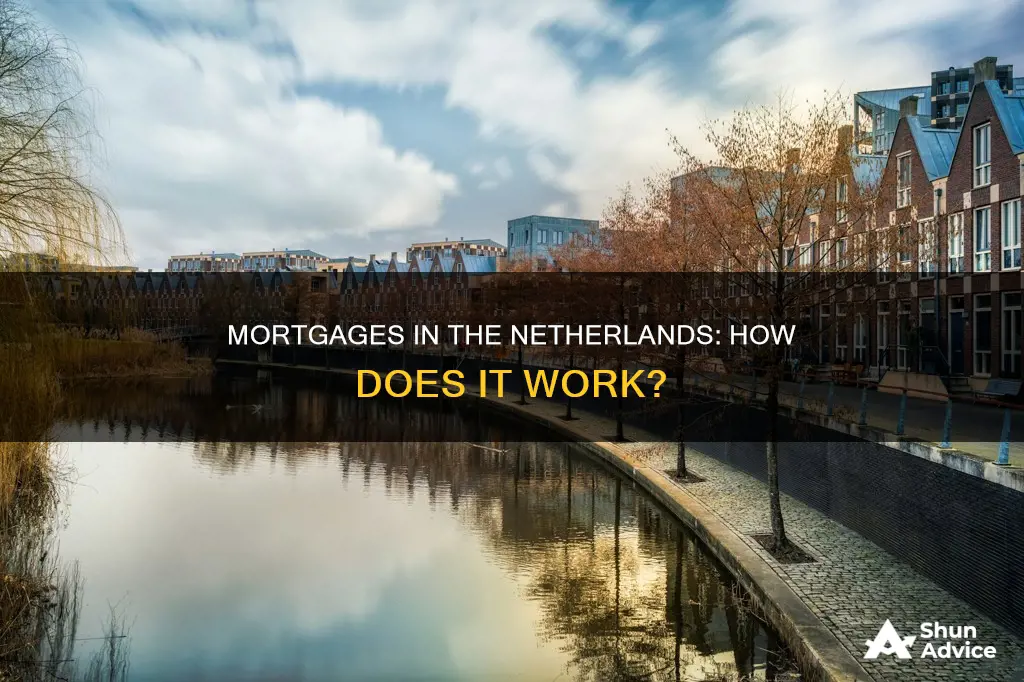
The process of obtaining a mortgage in the Netherlands can be complex, with many factors to consider. While both EU and non-EU citizens are entitled to take out a mortgage, non-EU citizens may face stricter requirements and additional challenges, such as the need to prove residency and provide income in a non-EU currency. The type of mortgage, interest rate, and duration vary, with the most common types being annuity and linear mortgages. The maximum amount that can be borrowed is determined by income, the market value of the property, and other financial considerations.
| Characteristics | Values |
|---|---|
| Types of Mortgage | Annuity, Linear, Endowment, Special Endowment, Investment-based, Savings-based, Bank Loan-based |
| Tax Breaks | Only available for annuity and linear mortgages |
| Maximum Loan Amount | 100% of the property value |
| Interest Rate | Depends on the type of mortgage, duration of the interest rate, and the amount borrowed |
| Discounts | Available for customers with ABN AMRO current accounts, and for homes with energy label B or higher |
| Requirements | BSN number, proof of residency, proof of income, proof of savings/assets, proof of debts/financial obligations, documents about the property, permanent contract, etc. |
| Additional Requirements for Foreign Applicants | Residence permit, proof of income in euros |
| National Mortgage Guarantee (NHG) | A Dutch system that ensures the borrower's mortgage will be paid off in full. The borrower pays a one-time fee to the Homeowners' Guarantee Fund, which will make the payments on their behalf if they are unable to. |
What You'll Learn

Mortgage requirements
The requirements for a mortgage in the Netherlands can be complex and vary between providers. Here is a general overview of what you need to know.
Firstly, you must live and work in the Netherlands to be entitled to a Dutch mortgage. Your salary must be paid in euros, as lenders will not accept a foreign currency. You will also need a Citizen Service Number (BSN) and proof of residency in the country. If you are not an EU or EEA citizen, you will need a residence permit. Some providers also require you to have lived in the country for at least six months.
If you are self-employed, you will need to show proof of income and tax payments for the last 24-36 months. It is much easier to get a mortgage with a permanent contract, although it is possible to get one with a temporary contract. In this case, your employer must state that your position will become permanent.
The amount you can borrow depends on your income and the market value of the house. You can borrow up to 100% of the value of the property, but you will also need savings to cover additional costs. These include property transfer tax, notary fees, and mortgage advice fees.
There are several types of mortgages in the Netherlands, but only two are eligible for a tax break on interest payments: the annuity and the linear mortgage. An annuity mortgage involves fixed monthly payments that include interest and repayment of the principal. A linear mortgage involves a fixed monthly payment, calculated by dividing the loan amount by the number of payments, with interest payments decreasing over time.
Markets: Money, Bonds, Stocks, and Mortgages, What's the Commonality?
You may want to see also

Types of mortgages
There are several types of mortgages in the Netherlands, but only two are eligible for a tax break on interest payments: the annuity and the linear mortgage.
Annuity Mortgage
An annuity mortgage, also known as a repayment mortgage, is a type of home loan in which the borrower pays a fixed monthly amount that includes both interest and repayment of the principal. In the early years of an annuity mortgage, monthly payments are largely made up of interest, with only a small part of the loan being repaid. Over time, as the debt decreases, the amount of interest you pay also decreases, and the loan repayments increase. With an annuity mortgage, you are eligible for a tax rebate of interest, but over time, the tax rebate decreases.
Linear Mortgage
A linear mortgage involves a fixed monthly payment. The payment is determined by dividing the loan amount by the number of payments. The debt and interest payments decrease over time until the mortgage is fully paid off at the end of the term. A linear mortgage is useful when you want to pay off your mortgage as quickly as possible, although initial repayments are relatively high.
Interest-Only Mortgage
With an interest-only mortgage, you make no repayments on the loan and instead just pay interest on a monthly basis. Banks only permit this kind of mortgage under certain circumstances, and you will need to repay the capital at a later date from savings or investment accounts. Interest-only mortgages offer more financial freedom at the beginning of the mortgage, with lower monthly payments when interest rates are low. However, there is no tax rebate, and at the end of the mortgage, you are left with outstanding debt.
Life Mortgage
With a life mortgage, you take out a life insurance policy to pay off your mortgage at the end of the term. During the mortgage term, you pay no mortgage repayments but instead make monthly payments towards your mortgage interest and your life insurance premium.
Bank Savings Mortgage
A bank savings mortgage allows you to set aside money in a locked bank account specifically for your mortgage repayments.
Bouwdepot (Construction Fund)
A bouwdepot is a loan alongside your mortgage, intended to help you renovate your house.
Understanding Mortgage Amortization: What, Why, and How?
You may want to see also

Tax implications
The tax implications of mortgages in the Netherlands can be complex and depend on various factors, including the type of mortgage, residency status, and whether the property is a primary residence or investment property. Here are some key points to consider:
Tax Deductions and Refunds
The Dutch Tax Authorities (Belastingdienst) support home ownership and offer several benefits when taking out a residential mortgage. The interest paid on a mortgage is generally tax-deductible, and this can result in annual or monthly tax refunds. This applies to specific types of mortgages, such as linear and annuity (repayment) mortgages. The deductible mortgage interest rate was 37.48% in 2025, but this rate gradually declines for higher-income earners. Additionally, certain costs associated with taking out a mortgage, such as notary fees, may also be tax-deductible.
Primary Residence (Box 1)
If the property is your primary residence, it is typically taxed under Box 1. Paying off the mortgage in full can have tax implications, including the loss of the mortgage interest deduction. This deduction allows you to reduce your taxable income by the amount of mortgage interest paid. Without this deduction, your taxable income may increase due to the eigenwoningforfait, which is a notional rental value added to your income.
Investment Property (Box 3)
For investment properties, the tax implications can be different. If you pay off the mortgage on an investment property, the net value of the asset increases without offsetting mortgage debt. This can raise your taxable base and potentially increase your Box 3 tax liability if your total assets exceed the applicable exemption threshold.
Non-Resident and Foreign Income Considerations
For non-EU citizens or those with foreign income, there may be additional tax considerations. Banks may have stricter requirements and may not provide mortgages above the National Mortgage Guarantee (NHG) amount. The Mortgage Credit Directive has also made it more challenging for internationals with non-EU currency income to obtain mortgages due to currency fluctuation risks.
Additional Costs (Kosten Koper)
When purchasing a property in the Netherlands, there are additional costs (kosten koper) that the buyer must pay. These costs are typically distributed by a notary, and many of them are tax-deductible. However, it is important to note that property prices listed in the Netherlands often exclude these additional costs.
Mortgages: Inflation Hedge for Long-Term Property Investors
You may want to see also

Additional costs
When it comes to taking out a mortgage in the Netherlands, there are several additional costs to be aware of. These costs are known as "kosten koper" (k.k.) and can amount to around 2% to 3% of the property's purchase price. Here is a breakdown of the potential additional costs:
Mortgage Advice and Brokerage Fees
You can either take out a mortgage directly from a bank or through an intermediary such as a mortgage broker. Both options typically charge a fee of around €2,000 to €3,000. Mortgage brokers offer a range of services, including financial overviews, investigating mortgage options, corresponding with banks, and handling documentation. The first "orientation" meeting with a bank or broker is usually free.
Notary Fees
You will need to pay notary fees for the deed of property conveyance (kosten leveringsakte) and the mortgage contract (hypotheekakte). These fees are typically included in the additional costs (k.k.) that the buyer is responsible for.
Property Valuation
A property valuation is often required when taking out a mortgage, and this cost is usually borne by the buyer. This can be a significant expense, especially when purchasing a new-build property.
Property Transfer Tax and Transfer Deed Fees
The buyer is responsible for paying the property transfer tax, which amounts to 2% of the property's purchase value. Additionally, there may be transfer deed (title deed) fees, which include notary fees and registration costs with the Dutch Land Registry (Kadaster).
Purchasing Costs
Purchasing costs can include expenses such as building survey fees when buying a new-build property or estate agent fees. These costs typically amount to around 5-6% of the property's purchase price.
It is important to note that the availability of certain mortgages and the associated costs may vary based on factors such as citizenship status, income, and employment history. The National Mortgage Guarantee (NHG) is also available to ensure individuals do not take out a mortgage beyond their means, providing a safety net in case of unforeseen circumstances.
Valuing Mortgage Bonds: The Intricacies of Pricing and Risk
You may want to see also

The application process
If you are self-employed, you will need to present your income history for 24-36 months, and it is much harder to get a mortgage approved if you have been self-employed for less than three years. A permanent contract will make the application process faster, but if you have a temporary contract, you may still be eligible if your employer states that your position will become permanent.
You will need to provide standard information such as your income, the value of the property, your employment contract, and your marital status. You will also need to prove your income, savings/assets, debts/financial obligations, and provide documents about the property. If you are a freelancer, you must show details of your earnings and paid taxes from the last 12 months.
There are several types of mortgages in the Netherlands, but only two are eligible for a tax break on interest payments: the annuity and the linear mortgage. The annuity mortgage is ideal for those who want more tax relief during the first years of their mortgage, while the linear mortgage offers the certainty of a fixed monthly payment. The maximum amount you can borrow on a mortgage is determined by your income and the market value of the house, and you can borrow up to 100% of the value of the property.
During the application process, you may wish to seek the advice of a financial advisor, particularly one experienced in dealing with expats. You can also make use of free orientation meetings with mortgage advisors, who will explain how much you can borrow and how they calculate the maximum amount. Once you have applied for offers with available banks, you may need to have your house valued and arrange for a bank guarantee. You will then need to maintain contact with the bank to reach a final agreement on the intended mortgage and maintain contact with the civil-law notary until the date of transfer.
Mortgage Pools: How Are They Sold?
You may want to see also
Frequently asked questions
You must be working and living in the Netherlands to be entitled to a Dutch mortgage. You will also need a citizen service number (BSN) and proof of residency in the Netherlands. If you are not from the EU or EEA, a residence permit is mandatory.
You will need to provide standard information such as your income, the value of the property, your employment contract and marital status. You will also need proof of savings/assets and debts/financial obligations.
There are several types of mortgages in the Netherlands, including the annuity mortgage and the linear mortgage. The annuity mortgage involves a fixed monthly payment that includes both interest and repayment of the principal. The linear mortgage involves a fixed monthly payment, determined by dividing the loan amount by the number of payments.
The amount you can borrow depends on your income and the market value of your house. There is no minimum income requirement, but lenders will conduct an affordability assessment to determine your qualifications.
You will need to pay a pre-sale agreement deposit of 10% of the purchase price after signing the preliminary purchase agreement. There are also property transfer taxes and notary fees associated with buying a property in the Netherlands.







